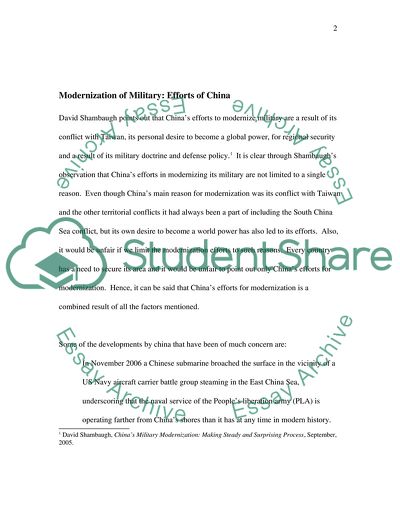Cite this document
(The Impact of Chinas Military Modernization on East Asian Security in Research Paper, n.d.)
The Impact of Chinas Military Modernization on East Asian Security in Research Paper. Retrieved from https://studentshare.org/military/1733404-how-do-we-assess-the-impact-of-chinas-military-modernization-on-east-asian-security-environment-in-decades-to-come-in-conjunction-with-other-factors-that-may-play-a-role-in-shaping-china-s-security-policy
The Impact of Chinas Military Modernization on East Asian Security in Research Paper. Retrieved from https://studentshare.org/military/1733404-how-do-we-assess-the-impact-of-chinas-military-modernization-on-east-asian-security-environment-in-decades-to-come-in-conjunction-with-other-factors-that-may-play-a-role-in-shaping-china-s-security-policy
(The Impact of Chinas Military Modernization on East Asian Security in Research Paper)
The Impact of Chinas Military Modernization on East Asian Security in Research Paper. https://studentshare.org/military/1733404-how-do-we-assess-the-impact-of-chinas-military-modernization-on-east-asian-security-environment-in-decades-to-come-in-conjunction-with-other-factors-that-may-play-a-role-in-shaping-china-s-security-policy.
The Impact of Chinas Military Modernization on East Asian Security in Research Paper. https://studentshare.org/military/1733404-how-do-we-assess-the-impact-of-chinas-military-modernization-on-east-asian-security-environment-in-decades-to-come-in-conjunction-with-other-factors-that-may-play-a-role-in-shaping-china-s-security-policy.
“The Impact of Chinas Military Modernization on East Asian Security in Research Paper”, n.d. https://studentshare.org/military/1733404-how-do-we-assess-the-impact-of-chinas-military-modernization-on-east-asian-security-environment-in-decades-to-come-in-conjunction-with-other-factors-that-may-play-a-role-in-shaping-china-s-security-policy.


